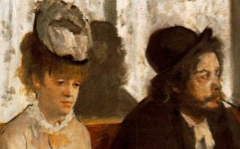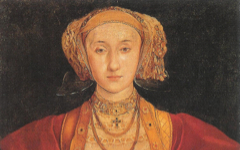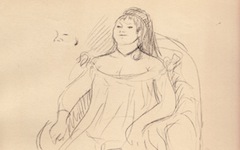Degas’ Galloping Horse (n.d.)

Degas, Galloping Horse [Cheval galopant] (n.d.) Charcoal on paper. Private Collection.
Click image to enlarge.
Degas, well-known as an illustrator of everyday life, was also an artist who depicted, over and over again, the act of creation in his mind. Even in a sketch like this.
Click next thumbnail to continue

Detail and diagram of Degas' Galloping Horse (left) with detail of an 1877 self-portrait, above and below.
Click image to enlarge.
Degas shaped the horse's hindquarters into the form of his own head, emphasizing the croup's contour over the rump. Shading on the right (see diagram and self-portrait) mimics his hair while a contour to the rump's left conveys his ski-slope nose. The location of the nose's "tip" is the only area that looks (at least to my layman's eye) anatomically odd. A joint protrudes above the leg where there should be none. "Errors" like this are often intentional, hints for those that can see.
Click next thumbnail to continue
Once recognized, the horse's neck protruding, so to speak, from the side of Degas' mind is twisted to the right like an artist looking over his shoulder in the mirror. [See "Over the Shoulder Poses") The horse is "drawing a self-portrait". That pose, as I repeatedly show, carries meaning. Even the raised foreleg is like an artist's arm about to draw.
Click next thumbnail to continue
Meanwhile the pastern of the nearest leg, the section between the hoof and fetlock, is emphasized with dark shading and unnaturally straight sides [see arrow.] The whiteness of the hoof provides contrast with both the pastern above and the underside of the hoof below. It suggests the shape of a piece of charcoal, the drawing's medium, with a squiggly shadow to the hoof's right as "a line" just drawn. The unnatural form of the shadow is yet another of those hints.
Click next thumbnail to continue
In summary, the view is inside Degas' mind where the horse (representing the artist himself) turns his head to look in the mirror while his body faces into the drawing to "draw" his own "self-portrait." A foreleg is raised to begin the creative act while the two other legs closest to it actually "draw" their own shadows, just as Degas, perhaps in a play on words, drew his. As so often,the scene depicts the very moment of the work's own conception.
More Works by Degas
Notes:
Original Publication Date on EPPH: 11 Jul 2014. © Simon Abrahams. Articles on this site are the copyright of Simon Abrahams. To use copyrighted material in print or other media for purposes beyond 'fair use', you must obtain permission from the copyright owner. Websites may link to this page without permission (please do) but may not reproduce the material on their own site without crediting Simon Abrahams and EPPH.




